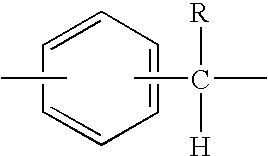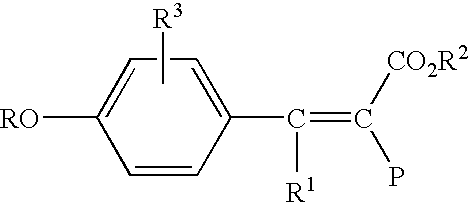High molecular weight polyester polymers with reduced acetaldehyde
a polyester polymer and high molecular weight technology, applied in the field of high molecular weight polyester polymers with reduced acetaldehyde, can solve the problems of loss of inherent viscosity during the molding of articles, high aa levels adversely affecting the taste of beverage contained in bottles, and long manufacturing time of solid statements, etc., to achieve a simple robust process
- Summary
- Abstract
- Description
- Claims
- Application Information
AI Technical Summary
Benefits of technology
Problems solved by technology
Method used
Image
Examples
example a
[0324]For polycondensation, ground oligomer (103 g) was weighed into a half-liter, single-necked, round-bottomed flask. The catalyst employed was titanium tetrabutoxide and it was added to the flask as a solution in n-butanol. Red and blue toners were added to the flask in the amounts shown in Table 4 for Example A. The amounts of red and blue toners were chosen in an attempt to obtain a similar chip a* and chip b* to those obtained for Comparative Example A as shown in Table 4. A 316 L stainless steel paddle stirrer and glass polymer head were attached to the flask. After attaching the polymer head to a side arm and a purge hose, two nitrogen purges were completed. The polymerization reactor was operated under control of a CAMILE™ automation system, programmed to implement the following array (Table 2).
[0325]
TABLE 2TimeTemperatureVacuumStir SpeedStageminutesC.°torrrpm10.1270730 0210270730 150*32270 140* 300*41270140300510270 51*30065270 5130071270 4.5*300820270 4.530092270 0....
example b
, C & D
[0337]To further compare the two catalyst systems when the finisher stage residence time was similar, the titanium level was kept at 5 ppm while the reaction temperature was increased to 289° C. The array in Table 5 was used.
[0338]
TABLE 5TimeTemperatureVacuumStir SpeedStageminutesC.°torrRpm10.1289730 0210289730 150*32289 140* 300*41289140300510289 51*30065289 5130071289 4.5*300820289 4.530092289 0.8* 30*1048289 0.8 30113289 650* 30122289650 30131289 0.5* 45*145289 0.5 45*= ramp
[0339]Red and blue toners were added to the PET oligomer prior to commencing the reaction at levels sufficient to target similar b* colors. Under these conditions, the finisher time for torque terminated Ti-catalyzed runs with a 0.8 Ih.V. target was about 48 minutes, and hence, the amount of time in stage 10. The smallest amount of the oligomeric phosphate triesters that could be reproducibly added by volume via syringe to the polymer is 0.02 mL, which corresponds to a target of about 20 ppm...
example e
, F & Comparative Sample C, D
[0343]These examples were evaluated to determined the amount of colorant required to obtain similar b* color levels for fully formulated polyester polymer compositions catalyzed using titanium and antimony. Also, the effect of colorant amount on L* color, reaction time to reach similar It.V. levels, residual AA in the solid polyester particles, as well as, AA generation rate upon melting were evaluated.
[0344]In Examples E & F, blue and red organic toners were added to target a disc b* color target of about 2 CIELAB units. A small amount (0.0005 g) of black iron oxide from Ferro, was added to increase the reheat rate of the Ti-catalyzed polymer to match the reheat rate of the Sb-catalyzed polymer.
[0345]In Examples E & F, phosphorus catalyst deactivators were added to polyester polymers catalyzed with low levels of titanium (5 ppm) at relatively low temperatures (270° C.). When terminating a polymer run at a torque equivalent to approximately 0.80 IhV, the...
PUM
| Property | Measurement | Unit |
|---|---|---|
| degree of polymerization | aaaaa | aaaaa |
| temperature | aaaaa | aaaaa |
| temperature | aaaaa | aaaaa |
Abstract
Description
Claims
Application Information
 Login to View More
Login to View More - R&D
- Intellectual Property
- Life Sciences
- Materials
- Tech Scout
- Unparalleled Data Quality
- Higher Quality Content
- 60% Fewer Hallucinations
Browse by: Latest US Patents, China's latest patents, Technical Efficacy Thesaurus, Application Domain, Technology Topic, Popular Technical Reports.
© 2025 PatSnap. All rights reserved.Legal|Privacy policy|Modern Slavery Act Transparency Statement|Sitemap|About US| Contact US: help@patsnap.com



